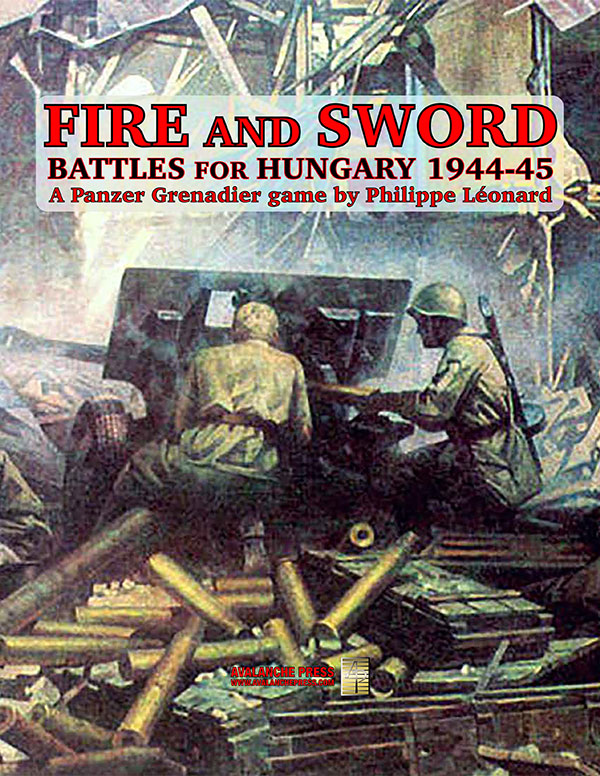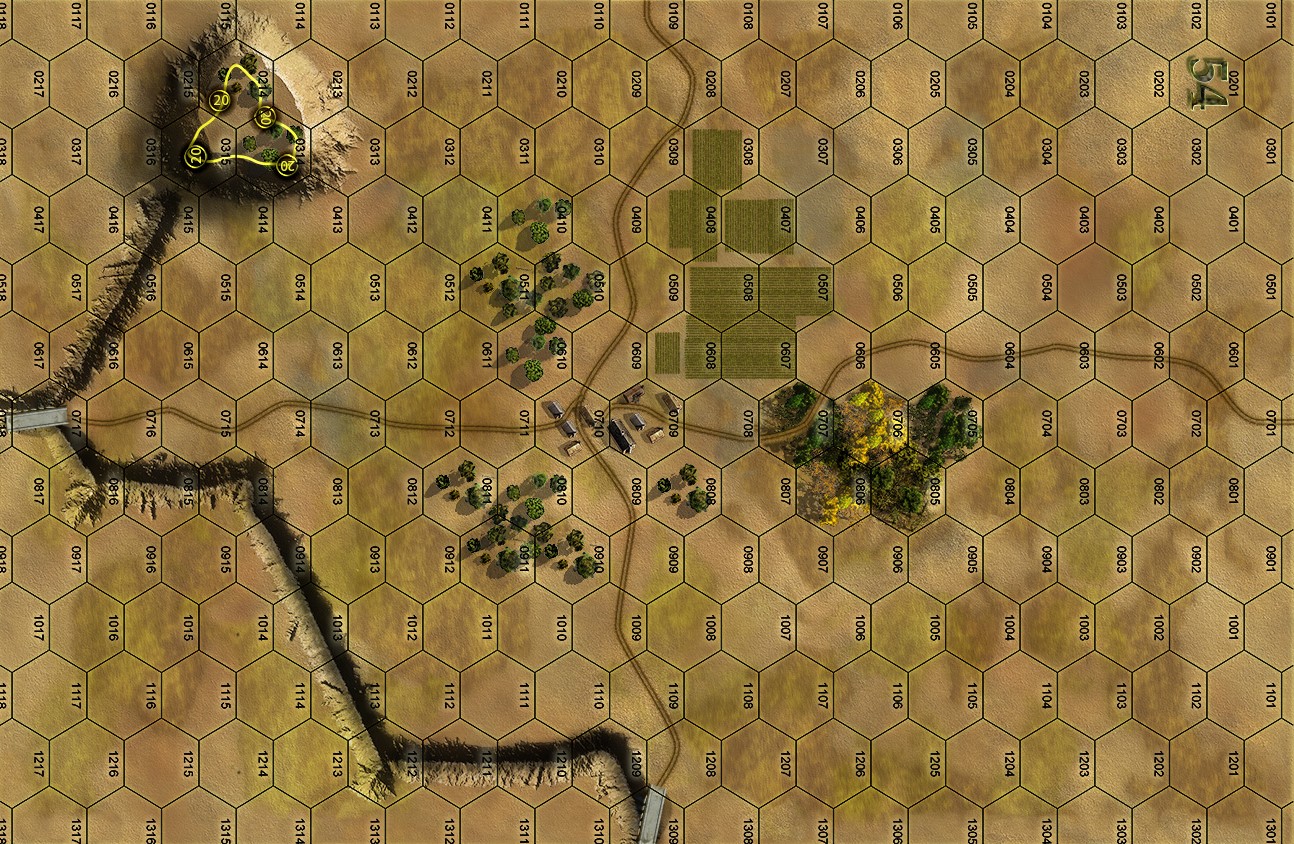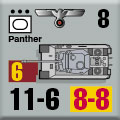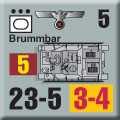| Fire & Sword:
Scenario Preview, Part Seven
By Mike Bennighof, Ph.D.
November 2024
 It’s been a while since we released a Panzer Grenadier game as large as Fire & Sword. And while size doesn’t always equal excitement, this time I think it does. It’s been a while since we released a Panzer Grenadier game as large as Fire & Sword. And while size doesn’t always equal excitement, this time I think it does.
Fire & Sword is a spectacular game, with five new maps (there’s one of them down below) and a whopping 913 pieces, along with 39 new scenarios. They’re all set in the Soviet offensive that rolled up to the gates of Budapest in late 1944, which saw tank battles and intense infantry assaults and river crossings. The Axis defenders threw everything they had into the defense, including armored trains, river gunboats, city police and tough Hungarian paratroopers. The Soviets countered with their awesome Js2 and T34/85 tanks, but also scraped their military prisons to field penal battalions.
It all makes for a great story, and designer Philippe Léonard tells it in our unique story-arc format, where the scenarios are built as part of the historical narrative, so you can both read and play your way through the campaign.

Let’s have a look at the seventh and final chapter.
See the rest of the preview here:
• Scenario Preview, Part One
• Scenario Preview, Part Two
• Scenario Preview, Part Three
• Scenario Preview, Part Four
• Scenario Preview, Part Five
• Scenario Preview, Part Six
Chapter Seven
The Encirclement of Budapest
Dissatisfied by the way the battle in Central Hungary was unfolding, Moscow decided on 12 December to bring the 3rd Ukrainian Front into the battle and redirect it from Vienna to Budapest. For that purpose, the STAVKA switched 46th Army from 2nd Ukrainian Front to Marshal Fyodor Tolbukhin’s 3rd Ukrainian Front.
While 4th Guards Army on its left hammered at the fortified land bridge between Lakes Balaton and Velence, 46th Army would attack the Axis lines north-east of Lake Velence, between the lake and the broad Danube River. The prime objectives remained unchanged: isolating the Hungarian capital from the west by attacking in the general direction of Esztergom, north of the Danube bend. Behind the frontline 10th Guards Rifle and 37th Rifle corps, Tolbukhin deployed the 18th Tank Corps as the exploitation force.

A Hungarian Turan II tank, seen in late 1944.
On defensive side, the German commanders made a capital mistake: they divided their three available panzer divisions by keeping their armored elements in the vicinity of Lake Velence and sending the bulk of the panzer grenadiers to the northeast, on the Garam-Ipoly battlefield. Therefore, the German battle groups had to confront Tolbukhin’s avalanche with a tank-heavy force accompanied by too few (if any) infantry.
The troops of the 3rd Ukrainian Front had a significant advantage over the German-Hungarian forces facing them: 3.3 times as many men, 4.8 times as many artillery pieces, 3.5 times as many tanks and assault guns, while the air forces were roughly equal.
The battle for Budapest now entered an even more intense phase.
Scenario Thirty-Three
Russian Mob
20 December 1944
Kápolnásnyék, Hungary
 Kápolnásnyék (it means “the chapel”) is a town located on the north-east shore of Lake Velence. Defended by the Hungarian-German Group Kesseö, the town had seen seesaw battles since the second week of December. At start of the big Soviet offensive to encircle Budapest, large infantry forces from the Soviet 180th Rifle Division made frontal assault against the Margit Line fortifications to capture Kápolnásnyék. Kápolnásnyék (it means “the chapel”) is a town located on the north-east shore of Lake Velence. Defended by the Hungarian-German Group Kesseö, the town had seen seesaw battles since the second week of December. At start of the big Soviet offensive to encircle Budapest, large infantry forces from the Soviet 180th Rifle Division made frontal assault against the Margit Line fortifications to capture Kápolnásnyék.
“The 1st and 2nd Hussar Companies,” Lt. Col. Emil Tomka, of the I/2nd Hussar Regiment remembered, “fighting delaying actions in the streets against numerically superior and fast advancing enemy forces, retreated. When Miklósi and Éber together with their remaining men finally managed to link up with the German assault guns, they launched an immediate counterattack. It could not get farther than the post office building because, occupying the whole width of the street running to Pázmánd, the Russian mob came pouring northwards.”
Conclusion
After an hour-long artillery bombardment, the Soviets advanced. Soon, the defense’s left wing collapsed and heavy street fighting erupted in Kápolnásnyék, on the German right wing. A few Sturmpanzer IV assault guns supported the Hungarians, especially in the hard fighting for the old post office building (Tomka’s headquarters) but they finally retreated to Pázmánd.
“A couple of shots, fired by the assault guns, cut through their ranks, wiping out the street and everyone in it,” Tomka continued. “But new crowds dashed forward one after another, also gaining ground among the ruined houses.”
The German-Hungarian forces of Group Kesseö tried to improvise a new front line, but by evening the Soviets were already on top of their positions. By the end of the day, the Soviet 46th Army had advanced about four to five kilometers to the north and northwest, capturing key villages. By nightfall, the Soviets had made a dent in the very heart of the defense and had punched a hole in the first defensive belt; but the Margit Line was not yet fully breached.
Notes
No, no, it’s not about Vlad and his American vatniki. The Russian mob is pretty big, deeply determined and backed by plenty of artillery. The Axis defenders range in quality from hardened panzer grenadiers to Hungarian militia and then the even worse SS militia cavalry. But they do have those Stupa assault guns.
Scenario Thirty-Four
Tank Battle at Pázmánd
21 December 1944
Between Pázmánd and Vereb, Hungary
 The Soviets knew that the Germans would use the night pause to bring forward reinforcements to restore their positions. Therefore, Tolbukhin decided not to wait until the rifle divisions achieved a breakthrough, but to unleash the exploitation force, the 2nd Guards Mechanized Corps, on the following the morning. In the pre-dawn hours, the dismounted mechanized brigades occupied their jumping-off positions behind the rifle units. As expected, the Germans had indeed reorganized their forces during the night. Battle Group Bayer of 6th Panzer Division with 28 Panthers, and Battle Group Pietsch, on its left flank, attacked at dawn before the Soviets launched their own assault, intending to restore the former main line of resistance. The Soviets knew that the Germans would use the night pause to bring forward reinforcements to restore their positions. Therefore, Tolbukhin decided not to wait until the rifle divisions achieved a breakthrough, but to unleash the exploitation force, the 2nd Guards Mechanized Corps, on the following the morning. In the pre-dawn hours, the dismounted mechanized brigades occupied their jumping-off positions behind the rifle units. As expected, the Germans had indeed reorganized their forces during the night. Battle Group Bayer of 6th Panzer Division with 28 Panthers, and Battle Group Pietsch, on its left flank, attacked at dawn before the Soviets launched their own assault, intending to restore the former main line of resistance.
Conclusion
Washed-out dirt roads hampered the vehicles’ movement, with any sort of speed only possible along paved roads and they weren’t many of those. The panzers soon ran into thirty Soviet tanks, whose fire halted the German advance. Although the Panthers destroyed a number of Soviet tanks, the attack by Battle Group Bayer failed. The lack of German infantry stifled the attack despite five waves of German air support. Soviet numbers simply proved overwhelming and the German tanks pulled back.
Notes
This is a tank battle. Only a tank battle: no infantry or anything else on either side, just tank against tank. A different sort of battle, one Milton Bradley would love.
Daily Content includes no AI-generated content or third-party ads. We work hard to keep it that way, and that’s a lot of work. You can help us keep things that way with your gift through this link right here.
Scenario Thirty-Five
Battle Group Pietsch
21 December 1944
Between Lovasberény and Velence, Hungary, 21 December 1944.
 During the night of 20-21 December, the 6th Panzer Division’s armored battle group marched from Lake Balaton and prepared a counterattack to cut the Soviets off from their rear areas. The rather weak group had plenty of Panther tanks, but only two companies of panzer grenadiers and some supporting arms. At around 1530, Battle Group Pietsch attacked through the forest towards Nadap and Velence, to open a corridor into the Soviet left flank. During the night of 20-21 December, the 6th Panzer Division’s armored battle group marched from Lake Balaton and prepared a counterattack to cut the Soviets off from their rear areas. The rather weak group had plenty of Panther tanks, but only two companies of panzer grenadiers and some supporting arms. At around 1530, Battle Group Pietsch attacked through the forest towards Nadap and Velence, to open a corridor into the Soviet left flank.
Conclusion
The Panthers, supported by their handful of halftrack-mounted panzer grenadiers and engineers, made their way through the wooden hills, and engaged in close combat in Nadap. After severe street fighting, they recaptured Nadap and advanced to the north-west perimeter of Velence. After recapturing that village, the assault continued towards Kápolnásnyék, with German anti-aircraft guns and some tanks dug in at Velence Cemetery. The Soviet command faced a critical situation on the left flank of the 46th Army, as the Germans had smashed the positions of the 180th Rifle Division and now seriously threatened the 10th Guards Rifle Corps’ rear areas. At 1600, Tolbukhin released the Soviet 18th Tank Corps to restore the situation. In the ensuing battle a dozen T34s were destroyed but the Soviets stopped the German advance. Without enough supporting infantry, the Germans could not hold their gains and they retreated, leaving them to the Soviet infantry.
Notes
The Germans are attacking with a somewhat unbalanced tank-infantry group; the Panzer Grenadier game system punishes tanks trying to operate without enough infantry. They’ll need to seize their objectives before they’re smothered in a wave of T34 tanks coming to the aid of the defenders.
Scenario Thirty-Six
Cross of Iron
22 December 1944
Between Pázmánd and Vereb, Hungary
 Having committed his exploitation reserve to clean up the German penetration of 46th Army’s left flank, Tolbukhin decided to keep them in action, ordering them to drive straight to the north towards Pázmánd. The Soviet offensive had stalled on either side of Lake Velence, and the Vozhd waiting in Moscow wanted results. Therefore, Tolbukhin threw in the other half of his reserve, the 2nd Guards Mechanized Corps, to advance on the tank corps’ right flank. The attack jumped off at 0800, and 18th Tank Corps met heavy resistance from the first minutes. Having committed his exploitation reserve to clean up the German penetration of 46th Army’s left flank, Tolbukhin decided to keep them in action, ordering them to drive straight to the north towards Pázmánd. The Soviet offensive had stalled on either side of Lake Velence, and the Vozhd waiting in Moscow wanted results. Therefore, Tolbukhin threw in the other half of his reserve, the 2nd Guards Mechanized Corps, to advance on the tank corps’ right flank. The attack jumped off at 0800, and 18th Tank Corps met heavy resistance from the first minutes.
Conclusion
About 40 panzers supported by air attacks immediately counterattacked the Soviet advance. The Panther battalion, detached from the Grossdeutschland Division, fought exceptionally well. Capt. Franz Bayer’s battle group of Panthers, halftrack-mounted panzer grenadiers and assault guns made rapid progress and took Hill 155 and Hill 152 south of Vereb, where they destroyed seven Soviet tanks and nine anti-tank guns, and captured 100 prisoners. Eventually, a Soviet strongpoint stopped their advance, and Bayer observed considerable Soviet armored forces assembling. The two hills became the focus of the Soviet attack, as they strove to outflank them and capture Vereb.
At around 1600 the Soviets finally captured the village; 18th Tank Corps made almost no progress at all due to the ferocious German counterattacks. Thanks to the assistance of infantry from 10th Guards Rifle Corps and the crucial help of the artillery, which maneuvered very quickly, the Soviet tankers succeeded in withstanding the severe Axis pressure. Bayer and his Panthers effectively covered the German retreat. Between 22 and 24 December, his battalion claimed 73 Soviet AFVs, 26 anti-tank guns and 17 trucks as destroyed or captured for the total loss of a single combat vehicle. Bayer would be awarded the Knight’s Cross on 9 May 1945 for his deeds in this battle; since Germany had surrendered on the previous day it appears that he never received his medal.
Notes
The Soviet numbers are vast, but the Germans have those überelite Panthers and . . . well, some less awesome help, both German and Hungarian. To win, the Soviets have to plow right through the Germans, which is not going to be easy even with their masses of tanks and infantry. This is true wargaming.
Scenario Thirty-Seven
Firestorm at Lovasberény
22 December 1944
Lovasberény, Hungary
 Located at the north-west corner of the Pázmánd battlefield, the village of Lovasberény housed a collection of German and Hungarian troops from shattered units, some supply elements, and several damaged tanks. At 0800, the attack on Vereb led some elements of the Soviet 170th Tank Brigade to bypass the west side of the village and to approach Lovasberény. There, at 0915, the Soviet tanks ran into the German-Hungarian rearguard. Located at the north-west corner of the Pázmánd battlefield, the village of Lovasberény housed a collection of German and Hungarian troops from shattered units, some supply elements, and several damaged tanks. At 0800, the attack on Vereb led some elements of the Soviet 170th Tank Brigade to bypass the west side of the village and to approach Lovasberény. There, at 0915, the Soviet tanks ran into the German-Hungarian rearguard.
Conclusion
When the Soviet tanks burst into the village, they met 13 German tanks and assault guns in a wild melee. The few Hungarian hussars and some anti-aircraft guns set up a strongpoint in a brick works, while the artillery occupied the railway station. Tanks, assault guns and even self-propelled howitzers shot it out at point-blank range.
Most of Lt. Col. Tomka’s hussars fled as more vehicles were set ablaze everywhere in the village. Screened by the thick smoke of the flaming wrecks, most of the German artillery left the village. Meanwhile, the German tanks held Lovasberény and knocked out a dozen attacking Soviet AFVs, thanks to the intervention of Lt. Col. Hans Rudel’s tank-killing Stuka dive bombers and Hungarian FW190 fighter-bombers.
“The enemy pressure in front of Lovasberény became so great that the non-combat elements had to be evacuated” recalled Lt. Leopold Graf Rothkirch, leader of I/26 Panzer Regiment’s headquarters company. “No sooner had I driven out of the village when a Russian T34/85 came towards me in the same hollow along which I was driving. We were about 50 meters apart. I fired first and immediately scored a hit. After the third shot, the enemy tank was in flames. Then, as I was driving my tank up a hill, the engine suddenly quit. I climbed out and ran up the hill, where to my surprise I discovered that numerous tanks and armored troop carriers had already driven around the depression and the hill. The radio equipment was quickly removed from my tank and I climbed into a tank of Panzer Regiment 11. We then fired on my tank and set it on fire. With the three remaining damaged tanks we succeeded in setting ten more enemy tanks on fire and forcing the others to veer away. I myself destroyed five tanks, an AA/AT gun, and an AT gun. With four damaged tanks we had succeeded in destroying eleven enemy tanks and foiled the enemy’s armored attack, thus creating the conditions necessary for a planned evacuation of the village.”
Notes
This is only a small scenario, but it’s an intense one where you get to pit German Panthers against Soviet T34/85’s, the formula that gave birth to modern wargaming.
Scenario Thirty-Eight
On Habsburg Ground
23 December 1944
Alcsút and Tabajd, Hungary
 “The enemy is in full retreat.” “The enemy is in full retreat.”
So reported 46th Army intelligence on the morning of 23 December. The Soviet 17th Air Army concurred: “The enemy is carrying out a full-scale withdrawal of its rear services from the city of Budapest.” The Soviet 18th Tank Corps’ tankers drove relentlessly northward, cutting through the scattered Axis defenses to reach Esztergom on the Danube and seal the encirclement.
By noon, Soviet tanks were already fighting on the southern perimeter of Alcsút, the site of an old Habsburg palace. Shortly afterwards, at 1230, elements of the 32nd Motorized Rifle Brigade crossed the Váli-víz stream and established a bridgehead on the eastern bank, soon followed by tanks from the 110th Tank Brigade across a newly-secured bridge. Meanwhile, the Germans desperately tried to secure their supply lines to Budapest, launching several strong armored counterattacks.
Conclusion
In the morning hours, the 8th Panzer Division attacked from Tabajd, eastwards toward Budapest just as 18th Tank Corps drove into the same area. A fierce tank battle broke out in the afternoon between elements of the 18th Tank Corps and 25 to 30 German tanks. The German tanks advanced on Hill 198, two kilometers north-east of Alcsút. The 110th Tank Brigade engaged 20 Panthers just to the north of Alcsút while the 181st Tank Brigade concentrated its forces in the woods. At the end of the day, the 32nd Motorized Rifle Brigade joined the fight as well. Throughout the day, 18th Tank Corps came under attack by waves of 12 to 20 German aircraft. Despite this effective air support, German losses increased and Soviet reinforcements kept pouring in. The Germans eventually retreated and by 1700 the Soviets had captured both villages. Sadly, several artillery rounds hit Palatine Joseph’s castle.
Notes
This is almost a meeting engagement, with the burden of attack on the Germans. Once again, we see a fight between plenty of Panthers and T34/85’s, the way wargaming was meant to be.
Scenario Thirty-Nine
Pitched Battle
25 December 1944
South of Esztergom, Hungary
 Having blocked the escape routes leading out of Budapest, the 18th Tank Corps resumed its drive to the north in the early hours of 25 December to seal the encirclement of the city at Esztergom. The final kilometers proved far more difficult than anticipated because of fierce resistance in the small town of Dorog. Located at the southern perimeter of Esztergom, Dorog was defended by a handful of panzer grenadiers reinforced by 21 Hungarian Hetzers (manned by poorly-trained crews in their first battle) and some anti-aircraft guns. At 1000, the German LXXII Corps learned that the Soviets had broken through with eight T34s and cavalry. At 1100, the lead elements of the 181st Tank Brigade reached Dorog. A German 88mm anti-aircraft gun destroyed one of them at once and at 1400, the main Soviet attack on Dorog began. Having blocked the escape routes leading out of Budapest, the 18th Tank Corps resumed its drive to the north in the early hours of 25 December to seal the encirclement of the city at Esztergom. The final kilometers proved far more difficult than anticipated because of fierce resistance in the small town of Dorog. Located at the southern perimeter of Esztergom, Dorog was defended by a handful of panzer grenadiers reinforced by 21 Hungarian Hetzers (manned by poorly-trained crews in their first battle) and some anti-aircraft guns. At 1000, the German LXXII Corps learned that the Soviets had broken through with eight T34s and cavalry. At 1100, the lead elements of the 181st Tank Brigade reached Dorog. A German 88mm anti-aircraft gun destroyed one of them at once and at 1400, the main Soviet attack on Dorog began.
Conclusion
The Soviet 181st Tank Brigade crossed the Danube and quickly lost three T34/85s, whereupon the corps commander ordered the 32nd Motorized Rifle Brigade to bypass the village of Kesztölc. When darkness set in, the Soviets infiltrated the village and fierce fighting erupted. Soviet infantry captured Kesztölc at 1600 and renewed their attack on Dorog from the east. After more urban combat, Dorog fell 1800s. The defenders retreated towards Esztergom at nightfall, leaving five or six burned-out Soviet tanks on the field. On the following day, the Soviets dashed to the Danube at Esztergom and completed the encirclement of Budapest.
Notes
This is an odd scenario, with the Soviets on the attack across a broad but shallow front: all of their objectives are close at hand, but far apart. Both players have some serious choices in how they’ll allocate their forces.
And that’s all for Fire & Sword.
You can order Fire and Sword right here.
Sword of Fire
Fire & Sword
Stalin’s Tanks
Eastern Front Artillery
Retail Price: $145.96
Package Price: $120.00
Gold Club Price: $96.00
Take up the Sword of Fire Here.
Sign up for our newsletter right here. Your info will never be sold or transferred; we'll just use it to update you on new games and new offers.
Mike Bennighof is president of Avalanche Press and holds a doctorate in history from Emory University. A Fulbright Scholar and NASA Journalist in Space finalist, he has published an unknowable number of books, games and articles on historical subjects.
He lives in Birmingham, Alabama with his wife and three children; he misses his dog, Leopold.
Daily Content includes no AI-generated content or third-party ads. We work hard to keep it that way, and that’s a lot of work. You can help us keep things that way with your gift through this link right here. |
